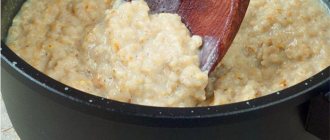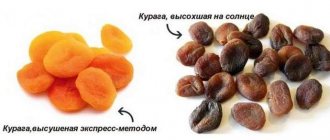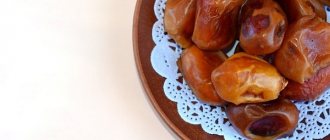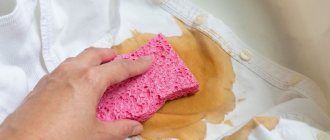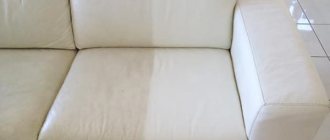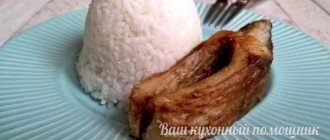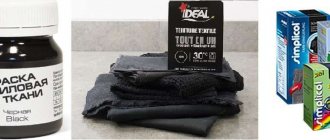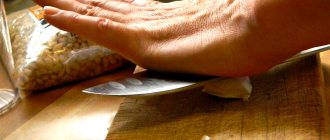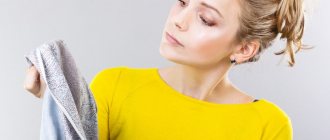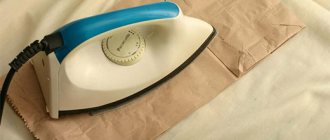There is an opinion that Domestos removes stains better than many modern products. This is partly true. The sodium hypochlorite it contains is an effective solvent. It is capable of removing the most complex and stubborn types of contaminants. However, its use in clothing is associated with great risk. The fabric may become thinner or the color of your favorite clothes may change.
Domestos is used as a stain remover in very measured doses. It is diluted in a large amount of water, and then the clothes are soaked in the solution.
How to bleach things at home?
Dissolve 2 tablespoons of grated laundry soap in 5 liters of water. You can add a couple of tablespoons of salt, soda, hydrogen peroxide or a few crystals of potassium permanganate to enhance the whitening effect. Soak the items for 2-3 hours, rinse and wash in the standard way.
Interesting materials:
What percentage of your salary goes to maternity benefits? What percentage of your salary goes on maternity leave? What percentage of salary is the pension accrued? What percentage of salary is paid on maternity leave? What percentage of salary is child support for three children? What percentage of salary goes to the pension fund? What percentage of salary is paid for sick leave? What percentage of the salary is paid in advance? What portion of your salary is alimony? How much can bailiffs deduct from their salaries?
How to use Domestos?
Despite the pleasant smell, Domestos is very pungent. It consists of sodium hypochlorite, surfactants and flavorings. In fact, this is an improved foaming analogue of “Whiteness”. It is used with great caution. Domestos should not be mixed with other chemicals or added to hot water. When using it to remove stains from clothing, you should wear rubber gloves.
Instructions for use:
- Pour cold water into a plastic basin and add Domestos at the rate of 25 ml (1.5 tablespoons) of product for every 2.5 liters of water.
- Stir the solution and soak your clothes in it for 10–20 minutes.
- Wash it by hand (with rubber gloves!) or machine wash it.
- When washing by hand, rinse the items thoroughly, otherwise burning and itching may occur when worn.
Before using Domestos on clothing, perform a test in an inconspicuous place.
Removing various stains
Knowing the origin of stains on clothes, you can increase the effectiveness of Domestos.
- Fat, sweat. Sprinkle powdered chalk onto the stain. Apply Domestos pointwise and leave for 3-5 minutes. Scrub the dirt with a brush.
- Juices, traces of fruit. Soak the laundry in warm water with added powder. After half an hour, apply the cleaner with a sponge to the stains. Rub in lightly. They will immediately disappear.
- Grass. Soak the stains with vodka or alcohol and leave for 15 minutes. Rinse in cold water. Wash clothes in a solution of 3 liters of warm water, 1 tbsp. spoons of washing powder and 1 cap of Domestos.
- Red wine. Wet the stain with warm water and rub with soap. After 10 minutes, rinse. Now saturate it with cleaning gel and rub lightly. After 3-5 minutes, rinse off.
- Blood. Wet the blood stain with cold water, add shampoo and lather. If the foam is colored, rinse it off and use shampoo again. Apply Domestos and rub the stain. After 7-15 minutes, wash your clothes as usual.
We recommend: How to remove machine oil from clothes
Review of Domestos products - composition and purpose
Preparations with the trade name “Domestos” are popular because they are economical, have high cleaning and disinfecting efficiency, and you can always purchase both a universal and a narrow-purpose product. The active ingredients are selected in such a way that, when used correctly, they are safe for humans and do not damage surfaces.
What's included:
- Natrii hypochloris (sodium hypochlorite or sodium salt of hypochlorous acid) is an inorganic compound, 95% of which is active chlorine. Chemical property - a strong oxidizing agent, quickly decomposes into sodium chloride (table salt), oxygen and water. Used for disinfection in medicine, everyday life, in production, as a bleach. It is active against many microorganisms that die as a result of the oxidation reaction of molecules occurring in the cells.
- Nonionic surfactants (surfactants) are compounds that help separate fatty contaminants from the surface and wash them off with water. Surfactant molecules attach fat molecules to themselves, and it is easily washed off. Nonionic surfactants have a mild effect and are biodegradable.
- Soap is added to enhance cleaning and disinfecting properties.
- Fragrances are necessary to neutralize unpleasant odors of chemicals and pollution.
Domestos household products come in different concentrations and are produced in the form of gels, sprays, toilet blocks, and stickers. The area and methods of application vary.
Table of comparative characteristics of Domestos disinfectants:
| Characteristic | Spray | Gel | Block | Sticker |
| What is it used for? | Treatment of surfaces made of wood, metal, plastic, ceramics | Treatment of surfaces made of wood, metal, plastic, ceramics | Toilet disinfection | Toilet disinfection |
| Mode of application | Spraying with a dispenser | Requires dilution in a certain proportion | Fixation on the headband | Fixation on the inner surface of the toilet |
| Peculiarities | Simple and easy to use | Difficult to distribute in hard-to-reach places | Narrow range of applications | Narrow range of applications |
You need to purchase this or that product based on the purpose and ease of use in each specific case.
Universal spray for surface disinfection
Household chemicals in the form of a liquid that does not require dilution are convenient to use. Sprays packaged in containers with a dispenser, which allows contactless spraying of the product on any surface, even hard-to-reach ones, are in greater demand.
Suitable for tiles, enamels, plastic, stainless steel, linoleum, plumbing. Effective against rust stains and grease deposits. Bottle volume – 500 ml, 750 ml.
How to use:
- open the dispenser by turning to the “Spray” function;
- spray onto the surface;
- wait three minutes;
- rinse off with a damp sponge or cloth;
- return the dispenser to the “Stop” position.
Users note that the spray acts quickly and removes grease, but it also has negative properties. For example, it does not cope with limescale, some people do not like the smell of bleach, suspensions enter the air and can penetrate the respiratory tract. Therefore, animals and children have to be removed from the treated area.
Reviews of the universal spray
Olga Petrovna, Penza
I’ve been using the universal spray for a long time and I like the results. I use it to clean the stove, sink, hood, oven, and treat the countertop in the kitchen, but I always work with the vent or window open and close the door, because the smell quickly spreads throughout the apartment. Sometimes I even cover my face with a scarf. But for me the effect outweighs the disadvantages.
Maruska, Perm
I'm not happy with the spray. I decided to clean my kitchen cabinets; they have a glossy finish. After spraying, I wiped it with a napkin, but there were still streaks. I had to wash it with warm water and then wipe it with a dry cloth. But it cleaned the sink wonderfully.
Domestos gels for the bathroom
The toilet and bathroom require special attention, so special products have been created for cleaning them.
These include:
- "universal spruce Double strength Freshness of the Atlantic." Contains sodium hypochlorite (<5%), anionic and nonionic surfactants, soap, fragrance. Effective against mold, bacteria, eliminates unpleasant odors, whitens. To wash walls, floors, and tile joints, prepare a disinfectant solution from Domestos - 4 caps of gel + 5 liters of water. Requires rinsing.
- "Universal gel Expert power 7 Ultra." Contains sodium hypochlorite, nonionic surfactant, soap, fragrance. Designed for the care of bathrooms, toilets, plumbing fixtures, effective against microbes, lime and fat deposits, and rusty deposits. The dispenser has been improved - spraying occurs through 7 holes. The gel, undiluted, is applied to the surface, under the rim of the toilet bowl, after 15-25 minutes, wiped with a sponge, brush, and rinsed off with warm (not hot) water. The price of 1 liter bottle is 400-420 rubles.
- "Domestos gel against blockages." Designed to remove blockages in bathroom pipes, under the kitchen sink, safe for any material. The concentrate is poured into the pipe, after 15 minutes it is washed with hot water for 5-7 minutes. Volume – 750 ml, price 170-200 rubles.
- "Active shield Lime Freshness" (Ocean Freshness). Does not contain chlorine. Contains 5% peroxide, acid compounds, fragrance. A protective layer is created on the surface, due to which less dirt accumulates, so one treatment per week is enough. Suitable for cleaning toilets, sinks, walls, shower stalls, and tile joints. Volume – 750 ml, price – 220-250 rubles.
After use, the room must be ventilated. It is not recommended to mix with other products to avoid unwanted reactions.
Toilet blocks
Toilet blocks are convenient to use and do not require human intervention after installation. The “Power 5” block is a plastic case with cells attached to the rim of the toilet bowl. The cleaning agent compressed into tablets is placed into the cells. When washed off, water gets on the tablets, foam forms, and a pleasant smell appears.
Special substances in the composition (surfactants, hydrocarbons, salts of phosphoric acids) prevent the formation of limescale, the surface of the toilet bowl remains clean and shiny longer, fragrances hide unpleasant odors. Not intended for reuse, service life - 2-5 weeks.
In addition to disposable ones, there are reusable blocks designed for repeated use. Contents: a bar in the form of a small piece of soap. Consists of cleaning agent, surfactants, phosphates, alcohols, fragrances.
Contraindications
Domestos, like Belizna and household bleach (bleach), contains active chlorine. This highly alkaline product can not only corrode stains, but also cause harm to the fabric. They should not be processed:
- colored and black things. Domestos is a strong bleach. Previously, its analogues – bleach and “Whiteness” – were used to lighten jeans (so-called “varenki” were made);
- synthetics. Some types of artificial fibers react chemically with sodium hypochlorite. After contact with it, the color of the fabric changes. Snow-white synthetic clothing can turn pink, yellow or another unexpected shade;
- wool, leather, silk. Domestos corrodes these types of materials. After its use, they become thinner, quickly tear, and lose their attractive appearance.
It is important to understand that it is impossible to bleach an item evenly with a chlorine-based product. Many people hope to use it to remove stains from colored fabric, agreeing that all the paint will come off evenly. However, a miracle does not happen. The thing is simply covered with white streaks.
In conclusion, let us remind you once again: Domestos is not the best option for removing stains from clothes. It is too aggressive and not suitable for delicate fabrics, synthetics, colored and black items. Of course, you can bleach white T-shirts, shirts, and socks with it. But it is important to be sure that they are made of 100% cotton. Otherwise, things may suddenly turn pink. Usually this product is used for clothes as a last resort, when stains on white cannot be removed by anything.
We recommend: How to remove resin from clothes in a couple of steps
Method No. 1. Soda
This is the most affordable option that can be found in any housewife’s kitchen. Baking soda is a natural, cheap and safe product that can be safely used to whiten both adult and children's wardrobes.
How to bleach?
Dilute 5-6 tablespoons of soda in 5 liters of water (to enhance the whitening effect, you can add a couple of tablespoons of ammonia). Soak the items in this solution for several hours (2-3), then rinse thoroughly and wash in the traditional way. If there are yellow spots on things, then they should be boiled in a soda solution.
Important!
Only linen and cotton products (usually bed linen and towels) are allowed to boil. Do not boil clothing items - they use delicate fabric that can be damaged by high temperatures. Carefully look at the care label, it is on every item!
Which Domestos can be used for clothing?
It is optimal to use a special Domestos bleach for white clothes to remove stains from clothes. This product can also be added to the washing machine when washing white laundry. It contains a minimal amount of sodium hypochlorite. The manufacturer indicates the following dosage in the instructions: 100 ml of bleach per 5–6 kg of clothing.
As for other types of Domestos, folk recipes use the product in green and yellow packaging: “pine freshness” and “lemon freshness”. But many housewives do not recommend using “pink storm” to whiten clothes - it leaves pink marks.
We recommend: How to remove marker marks from different surfaces

